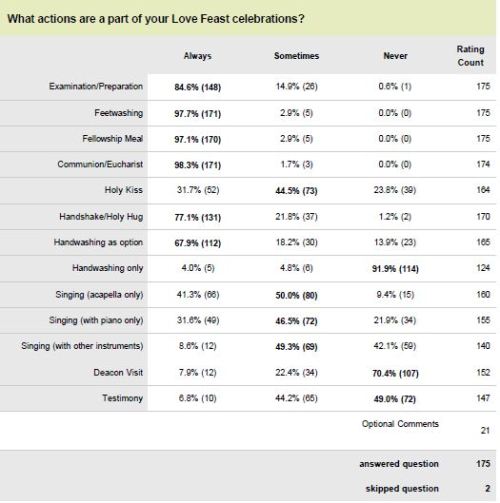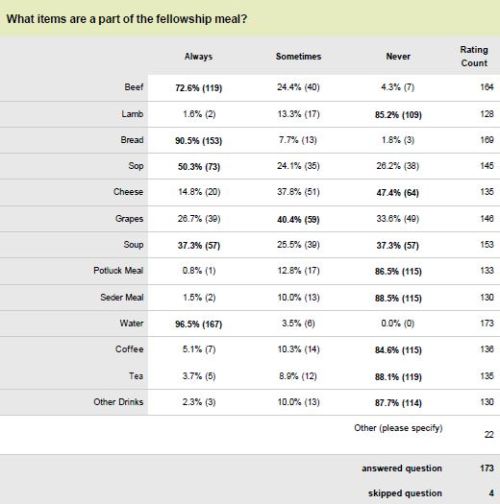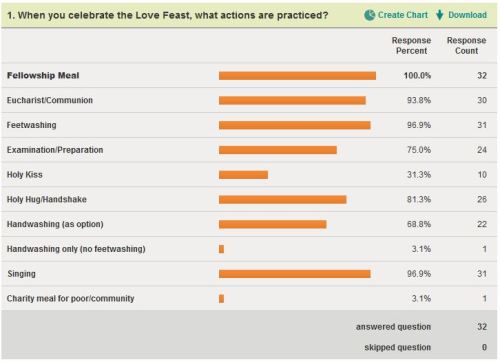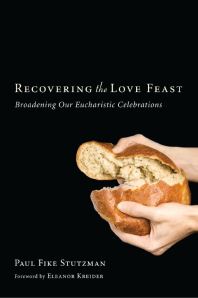Many of you may be aware that the United Methodist church has traditionally celebrated Love Feasts. Here is a recent article by Mary Jacobs of the United Methodist Reporter on the Love Feast. (http://www.umportal.org/article.asp?id=8364) PDF at this site.
Love Feast – UM churches savor simple Advent service
by Mary Jacobs, Staff Writer
Every year during Advent, since the mid-1970s, church members at First United Methodist Church in Brevard, N.C., have repeated the drill. They unpack the special mugs, the aprons and caps from storage; they order the yeast buns from a bakery in Winston-Salem, and they buy the beeswax candles and wrap them in red paper skirts.
It’s all in preparation for a special Christmas Eve service called the Moravian Love Feast, and it packs the church every year—with members of the church as well as folks from the community.
“Every so often we get a minister who thinks this might be something we should change,” says church member Donald Myracle. “He gets the message right away—this is the one thing you don’t change.”
Brevard’s Love Feast includes traditional Christmas carols, prayers, a few Moravian hymns and an offering benefiting a local charity. As worshippers quietly enjoy Christmas music, the young women of the church—many on break from college—don the lace caps and aprons and pass out the buns. Young men distribute mugs of hot cider. Then the candles—made of beeswax, symbolizing Christ’s purity—are handed out. The lights are lowered, the candles are lit and the service concludes in candlelight.
“It’s a very pretty service, very reverential and contemplative,” said church member Sarah Lee Myracle. “I always look forward to it as a time of reflection.
First UMC in Brevard is one of many United Methodist churches in North Carolina each Advent that celebrate the Love Feast, a popular tradition adopted from the Moravian church, which has a large number of congregations in North Carolina. The state is also home to what is likely the largest Moravian-style Love Feast in the U.S.—an ecumenical gathering at Wake Forest University in Winston-Salem, N.C. Attendees imbibe 90 gallons of coffee and 175 dozen yeast buns, and the college’s Wait Chapel is aglow with 2,200 beeswax candles.
 A simple meal
A simple meal
But Love Feasts aren’t just for Christmas. The broader tradition of the “Love Feast”—worship or fellowship centered on a simple meal—has a solid Wesleyan heritage, as well as roots that hearken back to the early church.
And it’s a concept that many Christians would benefit from rediscovering, says Paul Stutzman, author of Recovering the Love Feast (Wipf & Stock, 2011).
“The church was founded on a meal, the meal that Jesus shared with us,” he said. “The act of eating together is important to us as Christians.”
Early church roots
While its modern forms vary widely, the Love Feast “is basically a way of gathering that goes back to the book of Jude,” according to C. Michael Hawn, director of the Sacred Music Program at Perkins School of Theology, part of Southern Methodist University.
Early Christians celebrated Love Feasts in homes, enjoying a simple meal together followed by communion. By the third or fourth century, some Love Feasts were celebrated as communal, charitable meals which served meat—a rare treat for the poor. By the time Christianity became the official religion of the Roman Empire, the practice of the Love Feast began to fade in the Western church, according to Mr. Stutzman.
The modern history of the Love Feast dates to the 18th century, when the Moravians in Germany introduced a service of sharing food, prayer, religious conversation and hymns. In 1737, John Wesley experienced a Love Feast while worshipping with Moravians in Savannah, Ga.
“After evening prayers, we joined with the Germans in one of their love-feasts,” he wrote in his diary. “It was begun and ended with thanksgiving and prayer, and celebrated in so decent and solemn a manner as a Christian of the apostolic age would have allowed to be worthy of Christ.”
 Dr. Hawn notes that the Moravians were an oppressed people, with the earliest Love Feasts taking place on the estate of Count Zinzendorf, where Moravians had fled for protection. Thus, the Love Feast “was not just for nourishment, but a symbol of their being bound together in Christ’s love,” said Dr. Hawn. “It’s the idea of unitas fratrum—the unity of the brethren. This meal was meant to bring unity.”
Dr. Hawn notes that the Moravians were an oppressed people, with the earliest Love Feasts taking place on the estate of Count Zinzendorf, where Moravians had fled for protection. Thus, the Love Feast “was not just for nourishment, but a symbol of their being bound together in Christ’s love,” said Dr. Hawn. “It’s the idea of unitas fratrum—the unity of the brethren. This meal was meant to bring unity.”
With Wesley’s blessing, the Love Feast became part of Methodist society meetings in England, and those who immigrated to North America quickly made Love Feasts an important part of early American Methodism. But while Wesley’s inspiration came from the Moravian Love Feast, the practice among early Methodists was quite different from the Christmas service that’s now popular in North Carolina.
“For one thing, Wesley’s practice was closed,” said the Rev. Taylor Burton-Edwards, director of worship resources for the General Board of Discipleship. “You had to bring with you a ticket from your class leader certifying that you were in good standing in your class meeting.” These Love Feast services focused on testimonies—which was why the service was closed.
“Some of those testimonies were of overcoming sin or struggling with sin or other issues—not the sort of thing most folks would want to talk about in a more public arena,” he said.
Modern variations
Today, three denominations observe the Love Feast tradition—the Church of the Brethren, the Moravian Church, and the United Methodist Church, Mr. Stutzman said.
While the Love Feast wasn’t mentioned in the 1944 edition of the Methodist Book of Worship for Church and Home, an order of service for Love Feasts did appear in the 1964 edition. The current Book of Worship, published in 1992, outlines a Love Feast in the section on “Occasional Services,” appropriate for annual conferences and charge conferences, as part of Covenant Discipleship groups or congregational suppers, or as special worship during Christmas, Holy Week or Pentecost.
“The Love Feast, or Agape Meal, is a Christian fellowship meal recalling the meals Jesus shared with disciples during his ministry and expressing the koinonia (community, sharing, fellowship) enjoyed by the family of Christ,” according to the Book of Worship. Testimonies and praise are usually the focal point.
Communal meal
For the Rev. Russ Whaley, the Love Feast means opening the doors of his church, Zion UMC in Grand Forks, N.D., to everyone in the community for a communal meal. The church has been holding monthly meals, called Love Feasts, free of charge, to anyone who shows up, for the past 10 years. Other churches in town pitch in by providing food; each monthly meal typically draws around 200 people.
“Feeding the body is almost secondary to what we’re doing,” said Mr. Whaley. “There are a lot of folks who come, who need the people contact and the fellowship.”
There’s no preaching or formal worshipping as part of the meal, and while this Love Feast doesn’t follow the Book of Worship’s format, it does echo a traditional Love Feast theme: of sharing with those in need. Zion never accepts money for the meal, even from those who offer.
“It’s a completely free meal with no strings whatsoever,” said Mr. Whaley. “The whole idea is to express the grace and the love of Christ—which is freely given. You can’t attach a price to it.”
For the Rev. Donna Ware, pastor of First UMC in Hillsboro, Texas, the Love Feast was an experiment—a simple meal of donut holes, grapes and water shared as part of a recent worship service. Ms. Ware preached on the parable of the wedding banquet—about how the invited guests didn’t show, so the king gathered folks from the streets to enjoy the sumptuous meal.
“The Love Feast is a good way to talk about how God wants everyone to be at his table,” she said. “We’ve been fed, we’ve been invited; now we need to go out and invite others.”
Christmas tradition
Both of these variations fit the concept of the Love Feast, because it’s a very flexible form, according to Dr. Hawn, and because both echo the theme of sharing God’s abundance beyond the church’s walls.
But for most United Methodists in North Carolina, a Love Feast will always mean Christmas and the beloved traditions of the Moravian celebration.
Edenton Street UMC in Raleigh, N.C., has been celebrating a Love Feast during Advent since 1988. The earliest organizers turned for help to neighbors in the Moravian church, who gifted the church with a Moravian star to hang in the sanctuary. Edenton Street’s celebration has most of the features of the Love Feast at Brevard UMC—the special yeast buns, the beeswax candles with the red paper skirts, and the caps and aprons worn by the dieners (servers in German).
Edenton Street’s Love Feast takes place on the first Sunday of Advent, and year after year, always draws a big crowd.
“For us, it’s a way to start the Christmas season,” said church member Lewanna Stout. “It’s a family event—children 3 and up are invited—and it’s quite beautiful. And when it’s over, I always think, ‘Now I can start my Christmas.’”



 A simple meal
A simple meal Dr. Hawn notes that the Moravians were an oppressed people, with the earliest Love Feasts taking place on the estate of Count Zinzendorf, where Moravians had fled for protection. Thus, the Love Feast “was not just for nourishment, but a symbol of their being bound together in Christ’s love,” said Dr. Hawn. “It’s the idea of unitas fratrum—the unity of the brethren. This meal was meant to bring unity.”
Dr. Hawn notes that the Moravians were an oppressed people, with the earliest Love Feasts taking place on the estate of Count Zinzendorf, where Moravians had fled for protection. Thus, the Love Feast “was not just for nourishment, but a symbol of their being bound together in Christ’s love,” said Dr. Hawn. “It’s the idea of unitas fratrum—the unity of the brethren. This meal was meant to bring unity.”
